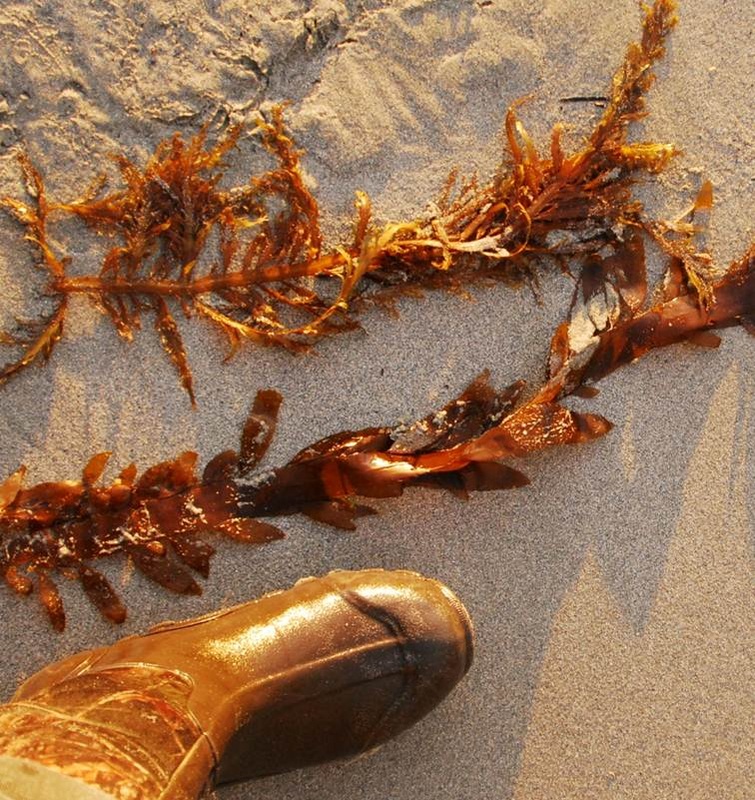Winged rib • Cumathamnion decipiens, Delesseria decipiens
Identification
This red alga is usually reddish-pink to light pink, though it can also be yellowish or deep purplish-red. It has a delicate, feathery-looking structure when in water, though it when out of water its structure is less definite. It has a thin, delicate blade on either side of the prominent midrib (a 'winged midrib,' as per the common name). Branches alternate and resemble the main axis: the branches also have midribs with the delicate blade continuing on either side. A major distinguishing feature of this species is that the branches sprout directly from the midrib of the previous branch. This branching pattern repeats several times. At the base the blade attaches to a small discoidal holdfast via a short stipe. Winged rib grows to 25 cm long.
Habitat & Range
This species is found in the low intertidal or shallow subtidal of semi-exposed or semi-protected habitats, but is only visible in the spring. Its range extends from the Kodiak Archipelago in Alaska to San Luis Obispo County in California.
Intriguing Info
This species has an isomorphic life history - the gamete-bearing and spore-bearing generations look identical. Male and female gametophytes occur as separate individuals.
This red alga is usually reddish-pink to light pink, though it can also be yellowish or deep purplish-red. It has a delicate, feathery-looking structure when in water, though it when out of water its structure is less definite. It has a thin, delicate blade on either side of the prominent midrib (a 'winged midrib,' as per the common name). Branches alternate and resemble the main axis: the branches also have midribs with the delicate blade continuing on either side. A major distinguishing feature of this species is that the branches sprout directly from the midrib of the previous branch. This branching pattern repeats several times. At the base the blade attaches to a small discoidal holdfast via a short stipe. Winged rib grows to 25 cm long.
Habitat & Range
This species is found in the low intertidal or shallow subtidal of semi-exposed or semi-protected habitats, but is only visible in the spring. Its range extends from the Kodiak Archipelago in Alaska to San Luis Obispo County in California.
Intriguing Info
This species has an isomorphic life history - the gamete-bearing and spore-bearing generations look identical. Male and female gametophytes occur as separate individuals.
References
Lamb, A., and Hanby, B. (2005). Marine Life of the Pacific Northwest [electronic version]. Madeira Park, BC: Harbour Publishing.
Lindberg, M. and Lindstrom, S. (2010). Delesseria decipiens. Seaweeds of Alaska. Accessed 14/11/2014.
O'Clair, R. and Lindstrom, S. Delesseria decipiens J. Agardh. In Klinkenberg, Brian. (Ed.). E-Flora BC: Electronic Atlas of the Plants of British Columbia. Lab for Advanced Spatial Analysis, Department of Geography, University of British Columbia, Vancouver. Accessed 14/11/2014.
Authors and editors of page
Joel White, Kelly Fretwell and Brian Starzomski (2014).
Lamb, A., and Hanby, B. (2005). Marine Life of the Pacific Northwest [electronic version]. Madeira Park, BC: Harbour Publishing.
Lindberg, M. and Lindstrom, S. (2010). Delesseria decipiens. Seaweeds of Alaska. Accessed 14/11/2014.
O'Clair, R. and Lindstrom, S. Delesseria decipiens J. Agardh. In Klinkenberg, Brian. (Ed.). E-Flora BC: Electronic Atlas of the Plants of British Columbia. Lab for Advanced Spatial Analysis, Department of Geography, University of British Columbia, Vancouver. Accessed 14/11/2014.
Authors and editors of page
Joel White, Kelly Fretwell and Brian Starzomski (2014).




